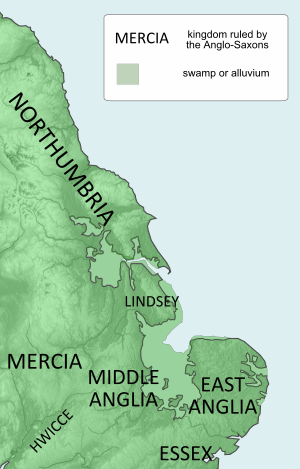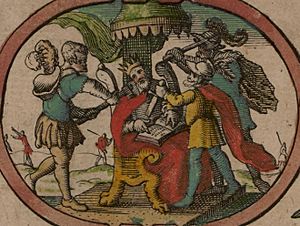Ricberht of East Anglia facts for kids
Quick facts for kids Ricberht |
|
|---|---|
| King of the East Angles (possibly) | |
| Reign | about 627–630 |
| Predecessor | Eorpwald |
| Successor | Sigeberht with Ecgric |
| Religion | Anglo-Saxon Paganism |
Ricberht (Old English: Ricbyhrt) might have been a king of East Anglia. This was a small, independent Anglo-Saxon kingdom. Today, it is part of the English counties of Norfolk and Suffolk. We don't know much about Ricberht's life or his time as a ruler.
According to a historical book by Bede called Ecclesiastical History of the English People, Ricberht killed Eorpwald of East Anglia around 627. This happened shortly after Eorpwald became king. Eorpwald had just been baptized as a Christian. After Eorpwald's death, Ricberht might have become king. However, Bede and other writers from that time don't actually say this. East Anglia then went back to its old beliefs (paganism) for three years. Later, Sigeberht and Ecgric became kings together. They ended this short period when the kingdom had turned away from Christianity.
Early East Anglian Kings
The first kings of East Anglia followed old, non-Christian beliefs. They belonged to the Wuffingas family. This family was named after Wuffa. Their ancestors came from northern Europe. Members of the Wuffingas family ruled the East Angles almost continuously. This lasted until after the time of Ælfwald in the mid-700s.
When Bede first wrote about East Anglia, it was a strong kingdom. It was ruled by Rædwald (who died around 624). Bede said that Rædwald was seen as having power over the southern Anglo-Saxon kingdoms. He gained this power by supporting Edwin of Northumbria. Edwin was a refugee at Rædwald's court. Together, they defeated Æthelfrith of Northumbria near the River Idle.
Rædwald became a Christian in Kent. This happened after King Æthelberht invited him. But Rædwald's wife followed the old beliefs. So, his church had both a Christian and a pagan altar.
After Rædwald died around 624, his son Eorpwald became king. Eorpwald became a Christian soon after. Historian N. J. Higham suggests that Edwin of Northumbria and his bishop, Paulinus of York, convinced Eorpwald to accept Christianity. This new religion's power came from outside East Anglia. King Edwin might have sponsored Eorpwald's baptism. This would have meant Edwin was seen as Eorpwald's lord. The people of East Anglia might also have been baptized. This could have weakened Eorpwald's power as king. It also went against the long-held old beliefs.
Eorpwald's Death
Soon after Eorpwald became a Christian, Ricberht killed him. This might have happened because some people who followed the old beliefs were unhappy about East Anglia becoming Christian. We don't know anything about Ricberht's family or background. But his name suggests he was an important person in East Anglia. He might even have been related to Eorpwald.
Bede's Ecclesiastical History is the only source that mentions Ricberht. It says that "Eorpwald, not long after he had embraced the Christian faith, was slain by one Ricberht, a pagan." We don't know where Eorpwald was killed. We also don't have any other details about his death.
Ricberht's Time as Ruler
Historians generally believe that Ricberht ruled for three years, if he became king at all. Bede does not mention him again. Bede only notes that "the province was in error for three years." This means the kingdom went back to its old beliefs. This was before Eorpwald's half-brother (or brother) Sigeberht and his relative Ecgric became kings.
Experts are not sure about the exact dates when kings ruled during this time. This includes Ricberht. Higham thinks that Ricberht was able to rule for three years. This was when Edwin was the most powerful Anglo-Saxon ruler. This suggests that the people of East Anglia supported Ricberht. They might have wanted to remove Eorpwald. They may have thought Eorpwald was too willing to obey the Northumbrian king.
Some historians, like Michael Wood, have wondered if Ricberht was buried at Sutton Hoo. This famous ship-burial site is near Rendlesham, where the Wuffingas family had their main power center. However, most experts think Rædwald is a more likely person to be buried there. Martin Carver has studied the old beliefs shown at Sutton Hoo. He believes the ship burial shows people resisting the "threat of a Christian mission."
Who Ruled Next?
Around 630, Christianity was brought back to East Anglia for good. This happened when Sigeberht and Ecgric began to rule together. Ecgric might have been a sub-king until Sigeberht stepped down around 634. Ecgric seems to have kept his old beliefs. There is no sign that Ecgric adopted or promoted Christianity. Bede did not write anything to suggest he was a Christian. In contrast, Bede praised the very religious Sigeberht. Sigeberht was the first English king to receive a Christian baptism and education before he became king.



